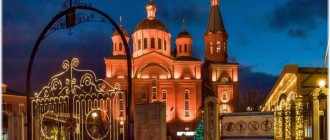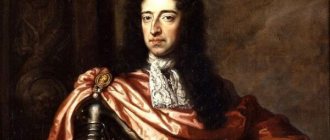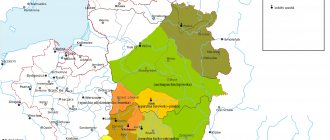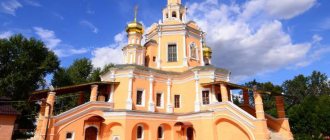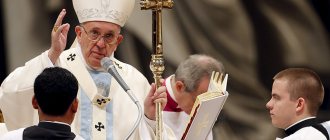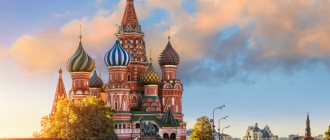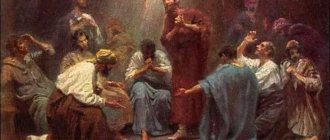There are a lot of speculations and judgments about the Greek Catholic Church, which are often politically motivated, especially in light of the events taking place in recent years in Ukraine. But if you dig deeper, everything turns out to be not so simple. Disputes about the truth of the dogmas of faith became an element of competition between countries for spheres of influence, and church hierarchs became conductors of state policy. Undoubtedly, the features of this denomination and its differences from the Orthodox Church bear a deep imprint of these processes.
What is the Greek Catholic Church
The concept itself consists of two roots, both of which come from the Greek language, which creates some confusion. The Latin word “union” further complicates the understanding of the issue for many. Therefore, let's take a dictionary and define this term.
Origin of the concept
“Katholikos” in Greek means “universal, whole,” but in the Russian tradition the more accepted translation of this word is “conciliar.” However, the generally accepted meaning of Catholicism is precisely that of a Christian denomination led by the Pope, its own system of doctrine set forth in the catechism, and a predominantly Western liturgical tradition. It includes both the Latin Mass and some others.
The prefix “Greco-” in this context has the meaning of the Greek or Byzantine liturgy, generally accepted in Orthodoxy. The question arises of how Western doctrine and Eastern worship can be combined in one church after the schism of 1054, when Rome and Constantinople went into schism and anathematized each other.
Union is the unification of the Roman Catholic Church with one of the Eastern Churches on the terms of the latter’s recognition of Catholic doctrine and dogma, but while maintaining its ritual, liturgical calendar and marriage license for the white clergy.
Not only Orthodox churches accepted the union, but also a number of Middle Eastern ones. Collectively they are called Eastern Catholic.
Meaning of the concept
In this vein, they usually talk about the Union of Brest in 1596, although it was only the first, but not the only one, in the East Slavic lands. However, today the Uniate Church is most often called the UGCC, which arose in Galicia, and the Uniates are the adherents of this denomination in the lands of western Ukraine. But still, this definition is very narrow and does not provide a complete answer to the question of who the Greek Catholics are.
In fact, we are not talking about a one-time event, but a whole series of agreements concluded at different times by Rome as part of the acceptance of several local churches under its protection. The process was long and took place during the XV-XIX centuries.
Greek Catholics are people who once professed Orthodoxy, and are now religiously cared for by the papal throne. Their rituals and traditions of worship remained the same. They are also called Catholics of the Byzantine rite, and this definition is the most accurate.
Greek Catholicism and Orthodoxy - similarities and differences of institutions
The similarities here are superficial. This is primarily a ritual and way of church life. In both cases, Byzantine liturgy is used, the possibility of services in the Old Church Slavonic language and the absence of celibacy among the white clergy. The Julian calendar (old style) may also be used for worship. The title of patriarch as the head of the hierarchy is used in both faiths.
The Orthodox world is a community of independent, or autocephalous, church organizations. Catholicism is an institution with a single vertical of spiritual power headed by the Pope, and Greek Catholics are built into this hierarchy. They are subordinate to the papal throne, are in eucharistic communion with it, recognize its dogma and at the same time have equal rights with other Catholics of both the Eastern and Western rites.
What does the main Greek Catholic offer?
On December 18 - that is, three days after the creation of the OCU - His Beatitude Svyatoslav wrote a letter of congratulations to Epiphanius. It was published on the UGCC website.
He congratulated the newly elected primate. And in the very first paragraph he stated that the council held in Kyiv was an important step “on the path to complete unity of the Churches of Vladimirov’s Baptism.” This very beginning speaks volumes.
Svyatoslav further stated that both churches should establish Eucharistic communion (that is, take communion together) and ultimately come to the “future patriarchy of the united Kyiv Church.”
“Although today we are not yet in full Eucharistic communion, we are called to jointly overcome the obstacles that stand in the way of unity. This historical mission and the foundation of the future patriarchate of the united Kyiv Church were laid by the glorious church men Peter Mogila and Joseph Velyamin Rutsky.
At this significant moment, I extend my hand on behalf of our Church to you and all Orthodox brothers, inviting you to begin together to pave our path to unity, to truth. Because the future of the Church, our people and the Ukrainian independent European state depends on how much we cherish unity today and overcome what divides us.
It is God who unites us around himself,” Svyatoslav addressed Epiphanius.
History of creation and formation
The Church Schism, also known as the Great Schism, occurred in 1054 and finally consolidated the accumulated religious differences and contradictions between East and West. Nevertheless, contacts between Western and Eastern Christians continued, as did attempts to unite again - especially since the positions of the Eastern Christian communities weakened after the Crusades and Arab-Turkish conquests, and in the West a single hierarchy headed by the Pope continued to be maintained.
First Catholic Church of the Byzantine Rite
Sicily and southern Italy had a long Hellenistic history and culture, and after the establishment of Christianity, the spiritual power of Constantinople and the Greek liturgical tradition were strengthened here. However, Byzantine control over these lands was lost, and Rome, on the contrary, strengthened here both politically and religiously - in the Middle Ages in the West it was difficult to separate one from the other.
As a result, local communities, while maintaining Byzantine ritual, found themselves under papal dominance. The schism bypassed them. The so-called Italo-Greek Church emerges - the first structure in history to combine Western catechism and the primacy of the pope with the Eastern liturgical tradition.
Greek Catholicism is a phenomenon that arose within the Western Church itself long before the signing of the first acts of church union.
Further development of the system
As you can see, a precedent has already been created. In the 15th century, against the background of the weakening of Byzantium, Rome began to gradually impose its religious leadership on Constantinople. However, this was only possible temporarily and formally. But a century later in the Middle East, some adherents of the Assyrian Church came under the control of Rome, preserving the local liturgical tradition. In 1553, the Chaldean Catholic Church emerged - the first Uniates in history.
The experience was soon transferred to the Western Russian lands, which were then part of the Polish-Lithuanian Commonwealth. It was not possible to Catholicize too large an Orthodox population, so the Union of Brest of 1596 was seen as a compromise solution.
Further, the process gained momentum in the neighboring Austrian Empire. Under pressure from the authorities, the popes are dominated by the Rusyns of Transcarpathia and the Romanians in Transylvania, as well as other communities. But the opposite also happened when, after several partitions of Poland, entire dioceses returned back to the fold of the Russian Orthodox Church, which was an element of state policy.
In the twentieth century, Greek Catholicism continued to lose ground. Hundreds of thousands of people in Romania and Transcarpathia are converting back to Orthodoxy. The Ukrainian Greek Catholic Church is completely abolished for political reasons and is restored only after the collapse of the USSR.
Current situation
Today, a number of churches of the Byzantine rite are under the control of the papal throne.
They can have one of the following statuses:
- patriarchy;
- supreme archbishopric;
- archdiocese;
- diocese;
- Apostolic Exarchate.
The only patriarch on this list is Joseph I, head of the Melkite Church. He is elected by the synod, takes office and then, after a request, is accepted post factum into ecclesiastical communion with the papal throne. The patriarch in this system is equal in hierarchical dignity to the Western cardinal-bishop. The Supreme Archbishop differs from him in that after the synodal elections the candidacy must be approved by the Pope, and only then enthronement and assumption of office follows.
The Roman Curia recognizes the broad internal autonomy of eastern church organizations, using the term "sui iurus", that is, their use of their own canon law. This aspect was not systematized for a long time, but already in the twentieth century the so-called “Code of Canons of the Eastern Churches” was published specifically for Uniate Catholics.
How to understand the head of the UGCC
The bottom line of the words of the head of the UGCC is the following.
This is, firstly, an invitation to dialogue, and not an agreement to unite on any terms. Moreover, it was expressed in the most non-specific form. However, if specifics are discussed, it is only during bilateral contacts.
True, something was said: Eucharistic communion. Shevchuk does not explain how an Orthodox can take communion with a Catholic (even if it is “Greco”). But in theory there are only two ways - either an Orthodox becomes a Catholic, or vice versa.
However, unification here hardly means a transition to the OCU, which still has problems even with recognition within the Orthodox world itself. Whereas Greek Catholics have full international legitimacy through the Vatican. Therefore, it is likely that unity in the Uniate Church is clearly seen not in the form of a transition to Orthodoxy (we will talk in more detail about the motives of the UGCC below).
Secondly, it is interesting that Shevchuk used the name “patriarchy” when depicting the prospects of a hypothetical united church. While the OCU is just the metropolis of Constantinople. It can become a patriarchy only by emerging from subordination to Bartholomew. Which, according to the terms of the Tomos, does not exist and is not expected.
The head of the Greek Catholics cannot fail to understand this. Either he made a reservation - or in a veiled form he offers Epiphanius, with the help of the Uniates, to compete for a higher status of the new Orthodox Church.
And in this, Greek Catholics can play a significant role - after all, in many respects they have more weight in the church life of Ukraine than the OCU - even if they are strengthened by the absorption of the autocephalous church, as well as some parishes of the Moscow Patriarchate.
Structure of churches in the world
The transition to the control of the Vatican, with the preservation of the Byzantine liturgy, spread mainly in the countries of Central and Eastern Europe, as well as in lands once subject to Constantinople. First of all, this is a consequence of religious discrimination and proselytizing activities in Poland and Austria-Hungary.
Ukrainian
Perhaps this is the most famous Uniate structure in the former USSR. It has parishes mainly in Western Ukraine and among the diaspora. This is the second largest denomination in this country.
The UGCC has a complex history. Its canonical territory changed several times due to the divisions of the Polish-Lithuanian Commonwealth and the return of many parishes back to Orthodoxy. As a result, they survived only on the territory of pre-war Poland, and in the USSR the church was liquidated and recreated only after its collapse.
Melkite
The only Uniate structure with the Byzantine ritual tradition, which has the status of a patriarchy. It separated from the Antiochian Orthodox Church in 1724, which was the result of active missionary activity on the part of Rome. Initially, the Melkites existed only in the territory of what is now Syria and Lebanon, but later their influence expanded to other countries of the Middle East.
Today, the Melkites include more than 1.5 million believers, mostly of Arab origin. Past pogroms, the Israeli-Palestinian conflict and the Syrian civil war have led to mass emigration and the emergence of Melkite communities in the diaspora.
Romanian
After the Hungarian conquest of Transylvania, the Orthodox found themselves in an unequal position here. However, Catholicization and Magyarization affected mainly the top of society, while the majority of Romanians did not change their religion. But after these lands came under Austrian control, the authorities began to form Uniate institutions here. The people rebelled, religious oppression weakened, as a result of which more than half of Romanian Greek Catholics returned to their former faith.
After these lands became part of Romania, the growth of nationalism and the advent of the communist regime, Uniate structures in this country were abolished. After 1989, Greek Catholicism was again legalized, but lost a lot of ground - the number of parishioners fell from 1.6 to 0.5 million according to the Vatican, and the Romanian census shows a figure of less than 200,000. Granted the status of supreme archbishopric, the main territory of distribution and residence are located in Transylvania.
Rusinskaya
In fact, this name combines three different structures that arose and changed more than once after the adoption of the Union of Uzhgorod in 1646:
- Mukachevo diocese, re-created after the collapse of the USSR.
- Apostolic Exarchate in the Czech Republic (former Diocese of Presov).
- Archdiocese in Pittsburgh, America, caring for the diaspora.
The first two entities are directly subordinate to the Vatican. It is difficult to determine the total number of parishioners - many in the diaspora have joined the UGCC and consider themselves Ukrainians. The approximate number of ethnic Greek Catholic Rusyns is estimated at 420,000.
Italo-Albanian
This church already existed earlier, uniting the local Greek community, which accepted the patronage of the papal throne even before the schism. The situation changed in the 15th century, when Orthodox Albanians, who did not want to live under the Turkish yoke, moved to the lands of Southern Italy.
Throughout history, there has been a process of assimilation of the Italo-Albanians and their transition to the dominant Latin rite. There was a certain discrimination against Byzantine Catholics in church legislation - equality was finally established only in the 19th century.
Nowadays, the Italo-Albanians form two dioceses independent of each other; services are conducted in Greek, as well as Italian and Albanian. The number of parishioners is estimated at 56,000 people.
Albanian
This Balkan country began to accept Christianity back in the 1st century AD. e., being in the sphere of spiritual influence of Rome and Constantinople at the same time - by the time of the Middle Ages, both Catholics and Orthodox were represented here, and subsequent Turkish domination and partial Islamization made the religious map of Albania even more complex and mixed.
Back in 1628, the first community arose here, which was liquidated twice by the Turkish and communist authorities, respectively. Since 1992, church structures have been finally restored, have the status of an apostolic administration and unite about 3,800 believers.
Bulgarian
Bulgaria's Greek Catholics are a byproduct of the local Orthodox population's struggle for autocephaly and independence from the Patriarchate of Constantinople in the 19th century. Under the Turkish yoke, some of the Istanbul Bulgarians accepted the patronage of the pope and in 1861 received official recognition from the Sultan. After the actual proclamation of autocephaly of the Bulgarian Exarchate, most of the Uniates returned to their former faith.
However, some part still remains part of the Uniate institutions controlled by Rome. During the communist period, they persist, although they suffer oppression by the authorities. After 1989, former freedoms were regained and part of the lost property was restituted. Given the status of an apostolic exarchate, the number of parishioners is about 10,000 people.
Hungarian
The Byzantine rite in Hungary survived amid the mixing of different ethnic and religious groups due to mass migrations. The community included Rusyns, Romanians and Slovaks, as well as Protestants, who preferred the Greek tradition to the Latin liturgy.
The gradual Magyarization of the population and the introduction of Hungarian as a liturgical language completed the process of formation of Uniate institutions in the country. Today, there are two dioceses in Hungary, uniting about 255,000 believers.
Greek
Historically, in the territory of modern Greece, Catholicism had a noticeable presence only in the form of parishes of the Latin rite. The situation changed in 1856, when a small community of Byzantine Catholics arose. By the end of the 19th century, the first parishes and seminary had already appeared.
In 1923, the Uniate structures were finally formed and received the status of an exarchate. The community in Istanbul is only 20 people, while in Greece there are about 6,000 believers. There are also several parishes among the diaspora in the European Union countries.
Macedonian
Rome's first attempts to persuade the Macedonians to join the union date back to the 17th century, but they had no result. However, the Catholic archdiocese was founded here already in 1656. The local population had in the past a Bulgarian ethnic identity, and therefore the union here also became part of the costs of the struggle of the Orthodox Bulgarians for autocephaly. After the formation of Yugoslavia, local Greek Catholics formed a separate exarchate.
Among the Catholics of Macedonia, the majority are adherents of the Byzantine, and not the Latin rite - this is how it happened historically. Today their number is approximately 11,400. Another local feature is the presence of one common bishop for the Catholic structures of both rites.
Russian
In Russia, the Eastern Catholic mission began to operate legally in 1905 after the Tsar issued a decree on religious tolerance and the right of subjects to change their confession. As a result, sympathizers of the Roman Curia came out of hiding. The structure is officially recognized by the authorities, there was a parish and a magazine was published until 1917.
At the time of the revolution there were about 1,000 parishioners and 8 priests, mainly in Petrograd and Moscow. But as a result of persecution and repression, the community in the USSR was completely destroyed and survived only in emigration.
Church life was actively revived in the 2000s, when Rome appointed Bishop Joseph Werth as primate. In 2009, there were at least 30 communities in Russia and the emigrant diaspora, but there is no reliable data on the number of believers today.
Slovak
The lands of present-day Slovakia were in the past under the rule of Hungary, and then the Austrian Empire, therefore the transition to the control of the Vatican here took place within the same processes as in Transcarpathia. The structure was separated from the Mukachevo diocese in 1818, temporarily abolished by the communist authorities and soon recreated after the Prague Spring.
In the 90s, the church was reorganized and now consists of three dioceses in Slovakia and one in Toronto, Canada for the local diaspora. The number of parishioners is approximately 210,000.
Croatian
In Croatia, which was part of the Habsburg Empire, union was a gradual process. Orthodox Serbs who fled the Turkish yoke actively moved here. They often converted to Catholicism, preserving the Byzantine ritual. This is how the first Greek Catholics of Croatia appeared. Later, representatives of other nations joined their ranks.
In the 20th century, the Krizevica diocese, established back in 1777, unites not only Croats, but also all Greek Catholics of Yugoslavia in general. However, after the collapse of the country, the structure was reorganized - now the canonical territory is narrowed to the borders of Croatia proper and the diaspora, and parishes in Serbia and Montenegro exist on the basis of association. The number of believers does not exceed 44,000 people.
What revelations from God do Greek Catholics have?
Recently, almost all Western Ukrainian media reported the news that the monks of the UGCC hear voices not from God. What voices do the Uniates have from God then?
double click - edit image
(Painting, apparition and revelations of Christ nun)
In two monasteries of the UGCC - in the name of St. Theodore the Studite, who is located in the village. Kolodiivka, Pidvolochinsky district, Ternopil region, and in honor of the Entry into the Temple of the Blessed Virgin Mary in the village. Bolshie Borki, Ternopil region, - revelations and messages were distributed, recorded based on the voices heard by the nun Maria Baran. The Synod of Bishops of the UGCC, which took place on April 26-27, 2017, stated that the voices are not from God. Revelations appeared and existed quietly and peacefully since 2004, that is, for 13 years they were “from God,” and then suddenly, for some reason, it turned out that they were “not from God”!
I began to diligently search the Internet for records and articles about these revelations and... I found, by and large, nothing except a small excerpt authored by Maria Baran on one general confessional website. The essence of the instruction was as follows: to love God, to serve Him sincerely (with a diplomatic hint that not all UGCC priests are devoted to this), to pray the rosary... That is. everything that fits into the ecclesiology of the Catholic Church. I didn’t see anything unusual or “not from God.” Therefore, I do not draw conclusions from a short excerpt of text, but share my research with you.
The following shocked me. Hundreds of Western (Ukrainian) newspapers, even anti-church newspapers, distributed carbon copies of the statement of the UGCC synod about false revelations. It is surprising that, for example, about any miracle in the UGCC, there was no such excitement to spread it, but suddenly there was such an order! I am a social media user, a writer-publicist, and am familiar with the technologies of information wars and manipulation of consciousness. So, it is very clear and obvious to me that there were many of her records, due to the presence of links to the nun’s articles on various sites, but almost all of them are no longer valid. The websites of the above monasteries have been deleted. On official Catholic and Greek Catholic websites, all their article photographs have been removed. Pages and posts on Odnoklassniki and Facebook have been deleted...
There are technologies for “clogging information”, when, for example, articles with different content are mass-posted under the same title. Then the original information becomes inaccessible. Or when a different IP address is inserted into a search word or an old link, as a result, you end up on some “left” site, for example, in London. Or when “robots” (programs) are launched to filter out the information you are looking for.
The top of the UGCC, most likely represented by the IT specialists of the Ukrainian Catholic University (UCU), did their best, I give a compliment - the SBU was not nearby!
What is the danger from these revelations and for whom is it if such measures were used? Even the “separatists” were not banned like that in the Ukrainian space.
double click - edit image
(UGCC, Hegumen Anthony Grigory Planchak)
I started looking for information about the abbot of these monasteries, the Greek Catholic monk Studite. Hegumen Anthony Gregory Plancak comes from the Serbian city of Kula, most likely, judging by his dialect, he is Rusyn, graduated from the Pontifical Gregorian University and the Pontifical Oriental University. The Internet is full of his prayers, elements of divine services, sermons, which are composed in the spirit of Eastern Christianity, but executed in accordance with the mentality of the Rusyns, who previously adhered to the union line. Many of his lectures and sermons are on Greek Catholic and Catholic websites, in online magazines (not all have been “cleaned” yet). That is, for the Greek Catholic environment, he is a super-active monk, which means he is a literate person and does not look like a madman.
I return again to the resolution of the Synod of the UGCC, the church court. What is his fault?
The trial took place purely in the manner of Uniate holiness: the culprit or his representatives were not invited, the alleged heresies were not named, and faults were raised about “violations” of a disciplinary nature.
He spread the heretical revelations of Mary Baran, which “are not from God.” When he performed an exorcism, the demon did not come out canonically, because the father did not have his blessing for this. Let me clarify: until that moment, for 13 years, the demon came out canonically. As you know, even parish priests practice exorcism in the UGCC. Well, there were also testimonies from lay witnesses who saw that the abbot (!) left the monastery without a blessing and healed without a blessing either. It turns out that the laity know the schedule when the priest goes to lectures with a blessing, and when he goes to the store to buy a loaf of bread without a blessing. In a word, global crimes!
I reviewed many newspapers and websites of the UGCC, as well as secular ones, where is the heresy? Let me take a peek! No, you won't find it. Clearly something is wrong here. Why, if he and she spoke heresy, was it not presented as an obvious demonstrable fact worthy of condemnation by the entire flock?!
double click - edit image
(Fragment, an open letter from faithful Greek Catholics to the Primate of the UGCC in defense of the honor and dignity of Father Gregory Planchak and nun Maria Baran)
Then I came across an open letter to the head of the UGCC Svyatoslav Shevchuk from the trustees and the rector’s flock in defense of the honor and dignity of the priest (I feel funny and sad at the naivety of the truth seekers), where the following facts emerge.
The the letter tried to solve the problem: “ We turned to
His Beatitude Cardinal Lubomir Guzar , Vladyka Bogdan (Dzyurakh ) , Administrator of the Patriarchal Curia, Vladyka Igor ( Vozniak ) , Archbishop and Metropolitan of Lvov , Vladyka Vasily ( Semenyuk ) , Archbishop and Metropolitan of Ternopil - Zborovsk , Vladyka Milyan ( Shashik ) , Bishop of Mukachevo , Vladyka Fyodor ( Martynyuk ) , Bishop - _ _ _ _ _ _ _ _ _ _ assistant to the Ternopil-Zborovsk city , Cardinal to Riga Janis Pujatsu , Cardinal to Claudio Gugerott and the Papal Nunzi Ukraine , Cardinal to Augustino Valini to the Vicar General of the Papal See , Archbishop and Metropolitan of Lvov Mieczysław at Mokrzycki mu .
We also addressed the Synod of Bishops of the UGCC .”
“Everyone didn’t have time”
, - truth seekers report, can you imagine? But I, as a native of Western Ukraine, can also imagine how they spent money and not only on “incoming calls”. Should I go around this whole brethren? Take, for example, the price list: in order to receive a prestigious parish, a father in the UGCC must pay 7 thousand euros, the same amount for ordination (a Greek Catholic priest stated this on open air on a Ukrainian channel, https://bit.ly /2s7PqN8, we are talking about monstrous bribery, watch from 18 minutes); for the bishop’s visit to the parish, there is a contribution of 2 euros for each parishioner, regardless of whether they go to church. This is Europe, everything is in euros!
I letter further: “But am
revelation the main stumbling block ? Over the 20 years since its creation, the Deck has been a difficult journey for the community ( ... ). Monastic complexes were built and reconstructed in Kolod her in ke , Bolshie Borki, Dolina, Vyshnevchik, Ternopil region, a monastery complex in Pos i h and in a forest area with an area of 90 hectares, which belonged to Metropolitan Sheptytsky, and a monastery in Klyuchi, Ivano-Frankivsk region. the implementation stage: a complex of a monastery in Pos ichi , the monastery of Elijah the Prophet in the Ternopil region , and the like. And everything suddenly stopped on April 27, 2021. The monasteries are closed (...) Or maybe was the property of the monasteries that took away the peace of individuals ? ... Property built with the funds and faith of specific donors through Father Anthony Gregory Planchak ( ...) Maybe the Lords will finally find the time and courage to wipe away his mother’s tears? "
(The full text of the letter, under which there are interesting comments, has not yet been cleared: https://bit.ly/2scIChY).
Come on, God is with them, with those heretical voices and revelations, because the Church has officially condemned them. Now let’s move on to visions and revelations, which in the UGCC and RCC are “from God.”
double click - edit image
(Lvov, opening of the monument to the “great son” of Ukraine, the Austrian, Cardinal Andrey Sheptytsky)
Here, for example. The correspondence between Cardinal Andrei Sheptytsky and the Basilian nuns from the so-called Basilian nuns that took place during the war years deserves special attention. "contemplation" monastery of St. Elijah in the village. Sukhovolya, near Lviv. These nuns - and there were only 17 of them in the monastery - being in a state of exaltation, often had “visions” and “revelations of God” (often of a very peculiar nature), which they reported in detail to the cardinal.
One of the Basilians, Avksentia Ivanovich, on August 3, 1941, described a vision given to her from “the Lord Jesus Christ Himself,” “Who” gave her the opportunity “ to see and take a living part in the coronation of Hitler, which filled her soul and heart with indescribable joy and happiness
[1].
On August 19, 1941, Auxentia spoke in a letter to Cardinal Sheptytsky about an even more original vision of “three prophets ” (!) - the metropolitan himself in the image of a “Ukrainian prince” and on his sides, as on Tabor,
“leader Hitler in the image of St. Elijah ” and the Pope “ in the guise of the prophet Moses
[2].
As we see, in this “contemplation hierarchy” Sheptytsky found himself in the place of Christ - above the Roman Pontiff himself and Hitler. This greatly impressed Count Sheptytsky, due to the fact that he was building Napoleonic plans for union expansion throughout Russia, and saw himself as nothing less than a prince in Ukraine.
Another message from Auxentia contains the following wish to Hitler, which was commanded by “the Lord Jesus Christ Himself”: “To be a true, completely Catholic, connected with the Pope, who could give him all the necessary religious instructions, and at the end put
a golden crown on his head and name him His King of all Europe
."
And then the following wish of the Uniate “god” is attached: “ I wish that the German army would not spare anything in Russia, neither cities, nor castles, nor villages, for the Lord does not want anything left there...
[3].
double click - edit image
(Adolf Hitler is the Catholic king of Europe Andrei Sheptytsky!)
ABOUT! How similar this is to today’s Bandera-Uniate propaganda of Ukrainian radicals: “Destroy Moscow and kill the Muscovites,” who are always to blame for everything. And why not, if the Uniate “God” “Himself” commands it?!
It is quite possible that these Uniate visions “from God” were by no means the fruit of ecstatic “visions”, but were composed based on Hitler’s well-known interest in various kinds of occult and mystical practices. At the same time, as can be seen from the words of the nun Auxentia herself, Sheptytsky personally made corrections to the text describing the “visions”: “I am sending a letter for your kind review and correction. Your Excellence will graciously decide whether it is suitable, whether it should be reduced or supplemented[4].
Sheptytsky, in turn, sent reports about the “vienia” of the Basilians personally to Adolf Hitler. In particular, one of these letters from the Metropolitan to the Fuhrer has been preserved in the former party archive in Kyiv [5]. Sheptytsky's correspondence with the Basilians was published in 1988 by Klim Dmitruk.
It should be said that, in contrast to the visions of Sister Maria Baran, the “visions” of the Basilian nuns, in particular Auxentia, have still not been REFUTED by either Latin Catholics or Ukrainian Greek Catholics as false, and that they are “not from God.” ", it is not said anywhere. On this matter there was neither a convocation of a Council or a meeting of the Synod, nor any resolutions or refutations, oral or written.
For some time, even after the capture of Lvov by Soviet troops, records of these prophecies and visions were actively distributed among the flock of Catholics of the Byzantine rite (UGCC) and the ROC, thus fueling religious motivation to support fascism (Hitler) and the UPA OUN.
double click - edit image
(“Prophet” of the UGCC Pan-father Herman Budzinsky)
Modern prophecies in the UGCC during the Maidan period of the bloody coup are practically no different in content from those mentioned, especially in encouraging murder. A striking example of this is the prophecies of the master father of the Studite monk Herman Budzinsky, who is surrounded by the aura of a “soothsayer” and a martyr for the faith, which in the minds of believers gives his “prophecies” even more weight. Perhaps these prophecies were attributed to him in time by the “creators” of the UGCC hierarchs, due to their relevance for fratricide on the Maidan.
According to the Greek Catholic version, this was said by the “holy father” on the day of the referendum in 1991. Of course, the prophecy was also “from God”, here it is (I present it in theses, almost verbatim):
“...Ukraine was destroyed for 350 years by the Muscovites... we hope for a better life... the euphoria of independence will quickly pass... there will be a crisis for 13 years... in 25 years there will be 5 leaders... then third councils will come (
this is Yanukovych - author
) and it will be 15 years after my death
(he died in 1995)
... it will be a two-headed Soviet-communist hydra ... for the Poles' support of Ukraine, Moscow will make a second Katyn
(this is a famous plane crash - author)
...
( the following is a description of the Maidan scenario)
... Moscow is to blame for everything ... The rage of the people will be so terrible that third Soviets and communists will be caught on the streets and killed without trial .
And no one can stop this revenge of our people , because the crimes
that third Soviets and communists will commit against Ukraine and the people will be as terrible as Stalin’s. Only then will an independent Ukraine be born
!.. Shevchenko is a prophet, he must be understood as the Bible...
After Ukraine is led by a woman who is released from prison ... in 35 years Ukraine will become one of the strongest powers in the world. The same as America now ... Moscow will face collapse and complete decline.
It began with Vladimir and will end with Vladimir. This is the will of God" (full text https://bit.ly/1hQFqKe).
On the Maidan, in connection with this prophecy, in order to give it some sacredness and mysticism, they even organized an “underground” flash mob - they copied it manually and distributed it among the adherents of the “Maidan Witnesses.” It’s a pity, of course, that Yulia Tymoshenko let us down with her prophecy...
After a long time, lonely voices were still heard among the Uniate clergy who dared to say (“sorry, it didn’t come true…”) that this “prophecy” was false. But they have not yet been REFUTED either by the decision of the Church Court, or by the Synod of the UGCC, or by the RCC!
The prophecy itself, as we see, is a catechism-quotation for a “patriot”-Russophobe. It was actively discussed and distributed on social networks among the Greek Catholic flock and schismatics of the UOC-KP and UAOC. As they say, more than one button accordion was torn. I remember that even in their apology, the Uniates, “witnesses of the Maidan,” cited him as proof of the “divine inspiration” of the Maidan coup and fratricide, and therefore the future prosperity of Ukraine. Uniates in general still consider the Maidan to be such a great blessing for Ukraine that they even hold annual conferences called “God on the Maidan” at the Catholic University (UCU). (More about this in my article “Whose “god” is on the Maidan?”
https://bit.ly/2slMH3i .)
I then asked the Uniates why God did not fulfill “his” prophecies? And what do you think they responded? That “Moscow is to blame, it interfered with God”! The Uniate god probably never dreamed of such superpower for Moscow!
So, after the Uniate trial of Abbot Anthony Gregory Planchak and Maria Baran, I was pleasantly surprised and glad that there are still sane believers among the UGCC (with this statement I do not support the teachings of Catholicism itself). Imagine what a wave of dirt and slander people endure from “their own”, but at the same time they have the courage not to leave, to remain a man and a priest. I want to say that this situation is not only among the Uniates. But not all patience and humility pleases God.
I welcome the Galicians and those Rusyns who, in the bosom of one of the branches of Greek Catholicism (the Ukrainian Orthodox Greek Catholic Church), dared to speak out against lawlessness, for which they paid bitterly: their churches were destroyed, their priests were deported: https://bit.ly/ 2rJcQI3, https://bit.ly/2sHSygK, https://bit.ly/2s8CQhk. These videos contain facts about the lies, satanism and manipulation of the consciousness of the recently deceased Cardinal Guzar. The video is very strong, but in the Rusyn-Ukrainian language.
When, even before the Maidan, all the main confessions of Ukraine signed an Act of Agreement with European integration “values,” including the canonical UOC-MP, represented by the late Metropolitan Vladimir, it was clear to me that these Euro-Sodom values would become legally binding. And this is the moral death of the country, which is what we are seeing today. I openly appealed to my hierarchs about this before and after the Maidan: “This is a betrayal of Christ and Holy Rus'” https://bit.ly/2rdx49i. And the UGCC, UOC-KP, UAOC, as well as neo-Protestant sects, such as the Adelaji sect, lobbied for this codomintegration as much as possible.
Then I thought that it would be the pro-Bandera “churches” who would be the first to fall under the destroying skating rink of the Antichrist, and there would be persecution, and their churches would be closed. They will be forced to fulfill the entire set of European values: same-sex weddings, blessing gay pride parades, juvenile justice, microchipping... Everything is like in Europe!
Their nationalism was used for a coup d'etat, and then they themselves would be thrown out like a used rubber band and closed... But everything turned out to be much simpler: at the head of these churches, enemies in robes were placed, who are destroying the church from the inside: then there is no need to close the churches, they are already become pulpits for preaching the “prophecies” of fascism, Russophobia, and misanthropy. On their walls are “icons” of “holy” murderers (banders), liars, and devil worshipers.
double click - edit image
(UGCC clergy are wolves in sheep's clothing)
Those who are conscientious and believers will be expelled. For further persecution of believers and the collapse of the country, new necessary “visions”, “revelations”, “voices” will appear. The holy apostles warned us about all this:
“ There were also false prophets among the people, just as there will be false teachers among you, who will introduce destructive heresies and, denying the Lord who bought them, bring upon themselves swift destruction.
And many will follow their depravity, and through them the path of truth will be reproached. And out of covetousness they will entice you with flattering words; their judgment has long been prepared, and their destruction does not sleep ” (2 Pet. 2:1-3) .
(The article was written at the request of deceived believers of the UGCC, as I learned, some of whom have already returned to Orthodoxy, and most of all to Protestants. And it’s not surprising why).
Author: Doctor of Theology, Master of Religious Studies and Philosophical Sciences, Archpriest Oleg Trofimov
[1] Central State Historical Archive in Lvov, f. 201, op. 4″B”, no. 2662, l. 13-14 (quoted from: Dmitruk K.E. “Uniate crusaders: yesterday and today.” M. Politizdat. 1988, p. 270).
[2] Central State Historical Archive in Lvov, f. 201, op. 4″B”, no. 2662, l. 21 (quoted from: Dmitruk K.E. “Uniate crusaders: yesterday and today.” M. Politizdat. 1988, p. 270).
[3] Central State Historical Archive in Lvov, f. 201, op. 4″B”, d.2663, l.1-4, 9-10 (quoted from: Dmitruk K.E. “Uniate Crusaders: Yesterday and Today”. M. Politizdat. 1988, p.272)
[4] Central State Historical Archive in Lvov, f. 201, op. 4″B”, no. 2665, l. 1 (quoted from: Dmitruk K.E. “Uniate crusaders: yesterday and today.” M. Politizdat. 1988, p. 271).
[5] Former PA IIP under the Central Committee of the Communist Party of Ukraine, f. 57, op. 4, d. 338, l. 137 (German).
DEAR READERS! The author of the article, Archpriest Oleg Trofimov, due to persecution in Ukraine, is deprived of property, housing, and a place of ministry, he needs our help, we ask for help. Sberbank of Russia card: 676196000086178580
Subscribe to our channel in Yandex.Zen!
Click “Subscribe to channel” to read “Tomorrow” in the Yandex feed
History of the Uniate Church in Ukraine
Since Uniatism is most often associated with Catholics of the Eastern rite in Western Ukrainian regions, their history is worth considering separately.
Signing of the Union of Brest
The influence of the Kyiv Metropolis on the Orthodox population under the rule of the Polish-Lithuanian Commonwealth began to weaken. The growing Polonization of society and the prestige of Catholicism created the preconditions for union. The authorities also sought to strengthen the official religion in the context of strengthening Protestantism and the political struggle with the growing Russian Tsardom.
On October 6, 1596, Metropolitan Mikhail Rogoza convenes a council of supporters of unification with Rome. A declaration recognizing the primacy of the papal curia is signed, a prayer service is held and excommunication is announced to all clergy who do not recognize the union.
Further fate
The authorities proceeded from the fact that Uniatism was now the only legal confession for adherents of the Byzantine rite. Persecution begins, priests who did not accept the union were deprived of their parishes. The laity were discriminated against through loss of economic and voting rights. The Basilian monastic order was created - an organization that directly promoted the complete transition to the Latin rite and the final Catholicization of the population.
Religious confrontation develops into national and political conflict. Ordinary people, Cossacks and nobles rebelled; in 1648, Bogdan Khmelnytsky rebelled. Gradually, Russia is reconquering a number of lands, as a result of which parishes and monasteries are returning back to Orthodoxy. After the final division of Poland, the process accelerated, and in 1863, the last Uniate parishes of the Russian Empire were abolished in the lands of the Kholm region.
Liquidation of the UGCC at the Lviv Cathedral
In 1939, Western Ukrainian lands became part of the USSR. Soon a war begins, during which the Uniate clergy often takes the path of cooperation with the German occupiers and takes part in the formation of OUN and UPA cells - for example, the famous nationalist Stepan Bandera came from the family of a Uniate priest.
From the very beginning, the structures of the UGCC were under the close attention of the NKVD and were considered as potential anti-Soviet agents. Active recruitment work with the clergy begins - the authorities are preparing the ground for the abolition of the Uniate system.
The result was the convening of the Lviv Cathedral in 1946, where, under the slogan of the spiritual reunification of the Ukrainian people and a “return to the faith of the fathers,” the Union of Brest was abolished, and all parishes were resubordinated to the Russian Orthodox Church.
Soviet period
After the official ban, the UGCC goes into an illegal position. Many of its ministers have been repressed, as a result of which it is not difficult to find among them those who have already been canonized in our days as a blessed martyr or confessor. Services continued, but were held in secret, and much more often people, maintaining their previous beliefs, attended the Orthodox liturgy. At the same time, Uniate institutions in emigration are actively developing - exarchates are emerging one after another in Canada, the USA, Australia and Western Europe.
Current situation
After perestroika and the collapse of the USSR, the ban on the activities of the UGCC was lifted - most of the churches taken away in 1946 were returned to it. Uniate structures are strengthening and now cover the entire territory of Ukraine, including the eastern regions. The UGCC becomes the largest Eastern Catholic church organization, uniting more than 4.6 million believers.
In 2014, the Uniate clergy actively supported Euromaidan, including taking direct part in the unrest. After the outbreak of hostilities in the Donbass, the UGCC unconditionally took Kyiv’s position, including collecting money for the purchase of army equipment for the Ukrainian security forces.
Orthodox and Greek Catholics - common and distinctive features
It is worth mentioning the similarities and differences of the two faiths in more detail, touching on the ritual and theological aspects, as well as relationships, where sometimes there is almost more politics than religion.
Common and distinctive features
Both faiths are united by a common past, from which a single ritual tradition was inherited.
Its features are as follows:
- Byzantine liturgical rite;
- Julian liturgical calendar;
- the right of white clergy to marry once;
- Old Church Slavonic language of worship.
The difference between Greek Catholics and Orthodox Christians lies precisely in the area of doctrine.
Like their co-religionists in the West, the Uniates profess the following:
- the primacy of the Pope as the vicar of God, infallible in matters of faith;
- creed with filioque (the Holy Spirit comes not only from the Father, but also from the Son);
- divine grace is understood as mercy or a call from above, and not a specific action (“energy”) of God;
- the dogma of the Immaculate Conception of the Virgin Mary;
- the dogma of the physical ascension of the Virgin Mary into heaven;
- recognition of the Ecumenical Councils held after the schism of 1054;
- provisions on purgatory and the supererogatory merits of saints.
Relations between faiths
In the countries of the European Union, both directions generally maintain religious peace and tolerance. However, in the former USSR the situation is completely different - the relationship between these branches of Christianity is extremely politicized and overshadowed by conflicts over the redistribution of property and churches, even to the point of squatters. The image of a Uniate as a Nazi sympathizer, a Banderaite, a Ukrainian nationalist and a Russophobe has taken root in the mass consciousness. Questions of religion itself are relegated to the background.

